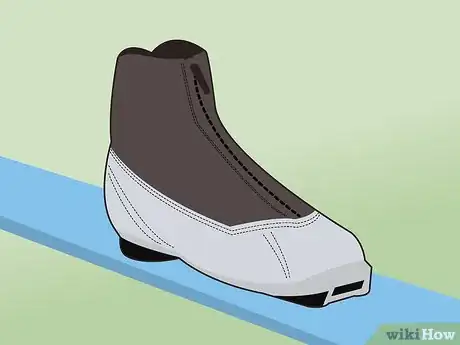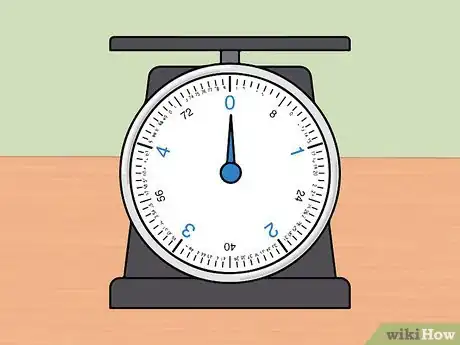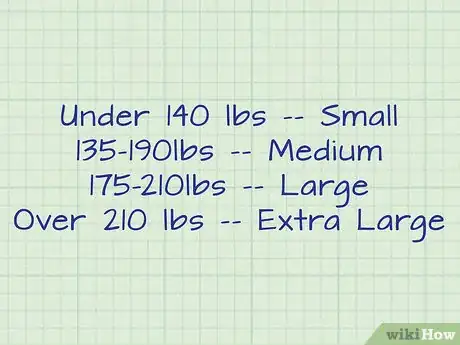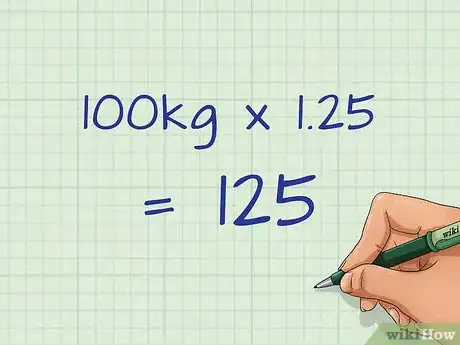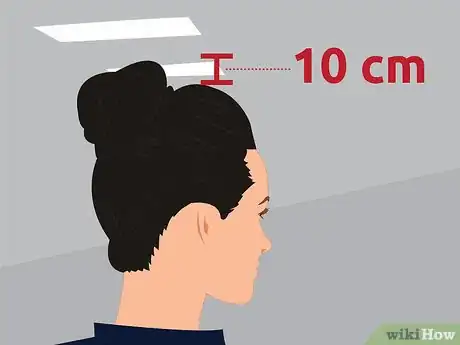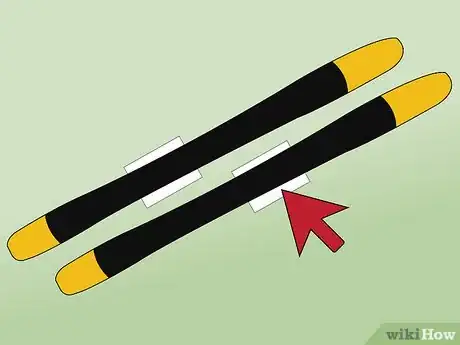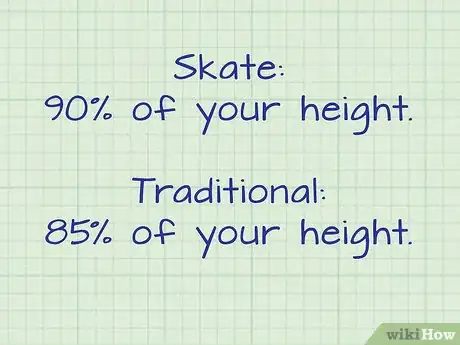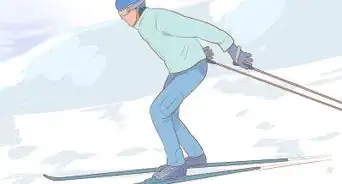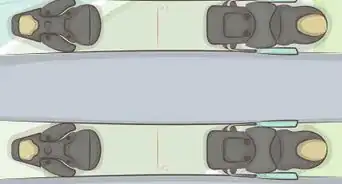This article was co-authored by wikiHow Staff. Our trained team of editors and researchers validate articles for accuracy and comprehensiveness. wikiHow's Content Management Team carefully monitors the work from our editorial staff to ensure that each article is backed by trusted research and meets our high quality standards.
There are 8 references cited in this article, which can be found at the bottom of the page.
wikiHow marks an article as reader-approved once it receives enough positive feedback. In this case, 92% of readers who voted found the article helpful, earning it our reader-approved status.
This article has been viewed 201,656 times.
Learn more...
Cross country skiing is a low-impact aerobic exercise that utilizes almost all the muscles in the body. It may improve your cardiovascular system and muscle tone. To ensure that you get the most out of this sport, it's important to find the right size cross country skis, as this will make your trips far more comfortable and enjoyable.
Steps
Finding Size Ranges for any Cross Country Ski
-
1Decide what type of cross country skiing you'd like to do, as they are all sized differently. The type of skiing you plan to do will determine how you need to size yourself, as each has slightly different uses and designs.
- Traditional or Classic skis are for groomed trails and all skill levels. They come in either normal or compact.
- Skate Skis are used for racing/speed skiing, and are usually preferred by intermediate or advanced skiers. They are shorter and thinner than traditional skis.
- Off-Track Skis are a hybrid between traditional and skate. They are wider than traditional skis and are used for open, ungroomed territory.
- Backcountry skis are shorter and used for longer off-trail explorations. They can be used in many terrains, and are light-weight as possible.
-
2Check the weight specifications of any set of skis before purchasing. Before you get to size and length, make sure you're in the weight range for each set of skis before buying them. In many ways, weight is more important than height for determining the right size skis, as bigger skis distribute more weight than smaller ones.[1]
- Some ski companies have even stopped using height to determine ski size, instead using unique weight ranges for each set of skis they produce.[2]
- Most skis will have a "recommended weight range" in their specification section.
Advertisement -
3Multiply your height in inches by 2.7, then add 15" to get a good approximation of Classic Touring skis. Note, however that this because most skis are sold in centimeters, not inches. If you're 6", you are 72 inches tall, meaning you'd aim for a 210cm set of skis.
- Note that this is an approximation -- you should try out a few pairs to see what you prefer whenever possible.
- The skis should always be 10-15 cm taller than you, never shorter.[3]
-
4Know that Compact Skis usually come in several pre-made sizes based on weight. Compact skis are less varied, and usually come in four sizes, small through extra-large. These sizes change based on the company making them but are usually recommended based on weight ranges. Note, however, that there is some overlap. If you have shorter legs and fall between two ranges, take the smaller skis. If you have long legs, grab the bigger size, but know that this is mostly up to preference:
- Under 140 lbs -- Small
- 135-190lbs -- Medium
- 175-210lbs -- Large
- Over 210 lbs -- Extra Large[4]
-
5Determine your skating ski size by experience level. For racing skis in particular, the longer skis are essential to build up speed. But more important than length alone is "camber," or the curve of the ski. The right camber can be found using a percentage of your body weight. To take percentage of you body weight, simply multiply your weight in kilograms by the percentage. So, if you're and intermediate and weigh 100kg, you would aim for a camber around 125 ().
- Beginners: Aim for a camber around 100-115% body weight in kg
- Intermediate: 110-125% body weight in kg
- Advanced: 120-130% body weight in kg.[5]
-
6Aim for back-country skis to be roughly 10cm taller than you when stood up end to end. Again, the exact size is up to comfort level, but you do want to make sure the skis are taller than you are by a few centimeters. Backcountry skiing is often for more experienced skiers with established preferences and comfort, and you should test out skis before buying. When in the backcountry, you'll be on those skis for hours at a time. Make sure they are the right size for you and your ski style before spending a ton of money.
- Backcountry skies should be wide, and may be a bit shorter than other types of skis.
Honing the Perfect Size for You
-
1Try out the "paper test" to see if the skis suit your weight well. On a hard floor, place a piece of normal paper underneath the skis. Step into them like normal, and slide back and forth. When you have weight evenly on both skis, the paper should slide around easily. When you have weight on just one ski, the paper shouldn't slide at all.
-
2Rent out a 1-2 sizes for a day to see what you are more comfortable on. If you're between the ranges of two sizes, or just feel unsure about them, then take them for a test. Many ski shops will let you test out the skis out back as well, and there is no excuse not to try on the skis before buying. Just like shoes or clothes, you should try something you're going to be using often to make sure it fits.
- Which ones move the smoothest under your feet?
- Where do you feel better balanced?
-
3If stuck between two sizes of skis, consider your leg length, not your total height. The length of your legs is more important to consider than your total height, and this is often the "tie-breaker" if you're in between sizes. That said, the best thing to do is try both pairs on and see which fits your body best.[6]
-
4If you're stuck between two weight levels, consider you experience level. The better a skier you are, the better prepared you are for longer skis. If you're in between the two weight classes, ask yourself honestly about your skill level and commitment to the sport. Better skiers should grab longer skis, and newbies should aim for something shorter.
- If you plan on skiing a lot, you might still aim for the bigger skis, even if you're not experienced. As you get better, you'll "grow" into the big skis, so you won't have to buy a new set of skis once you're a pro.
-
5Choose the right pole size for your type of skiing. In general, skate skiing requires longer poles, as you extend further out to the sides. Traditional skier usually like shorter poles, though not by much. In both cases, they should come up roughly to your armpits when standing straight up.
- Skate: Should be roughly 90% of your height.
- Traditional: Should be roughly 85% of your height.[7]
Community Q&A
-
QuestionHow long should your poles be if you are 5'2" tall?
 Community AnswerAround 135 cm for traditional. 5'2" in cm is 158 cm multiplied by 0.85. If you are a novice, go with traditional sizes.
Community AnswerAround 135 cm for traditional. 5'2" in cm is 158 cm multiplied by 0.85. If you are a novice, go with traditional sizes. -
QuestionHow thick is the paper that is used to check classic ski fit?
 Community Answer24.6 inches. There should be at least that much or more. There are different sizes, the biggest I've seen someone use was 56.4 inches.
Community Answer24.6 inches. There should be at least that much or more. There are different sizes, the biggest I've seen someone use was 56.4 inches.
References
- ↑ https://www.rei.com/learn/expert-advice/crosscountry-ski-touring-gear.html
- ↑ http://www.rossignol.com/US/US/nordic-sizechart.html
- ↑ https://www.skis.com/Sizing-Guide-for-Cross-Country-Skis/sizing-guide-9-13-2011,default,pg.html
- ↑ https://www.skis.com/Sizing-Guide-for-Cross-Country-Skis/sizing-guide-9-13-2011,default,pg.html
- ↑ http://www.cross-country-ski.com/links/how-to-size-ski-equipment
- ↑ https://www.rei.com/learn/expert-advice/crosscountry-ski-touring-gear.html
- ↑ http://www.cross-country-ski.com/links/how-to-size-ski-equipment
- http://www.skipost.com/gettingstarted.htm
- http://www.rei.com/expertadvice/articles/crosscountry+ski+touring+gear.html
About This Article
To size a traditional pair of cross country skis, start by multiplying your height in inches by 2.7, then add 15 inches to that number to get a good approximation of your size. Next, check to make sure that you're in the weight range for your chosen skis. If you're stuck between 2 sizes, go for the pair that best complement your leg length. If you're stuck between 2 weight levels, go for the shorter pair of skis. Try renting the skis before purchasing them so you can see how they feel out on the snow! For tips on sizing racing skis, read on!
